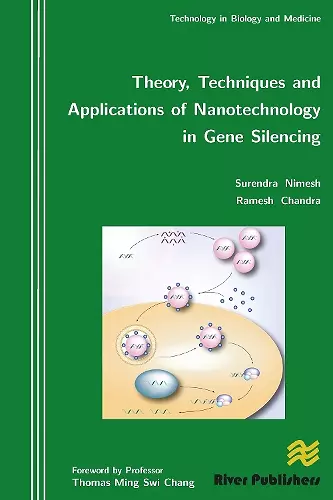Theory, Techniques and Applications of Nanotechnology in Gene Silencing
Ramesh Chandra author Surendra Nimesh author
Format:Hardback
Publisher:River Publishers
Published:6th Feb '12
Currently unavailable, and unfortunately no date known when it will be back

Gene silencing mediated through short interfering RNAs (siRNAs) is rapidly emerging as a new class of therapeutics for the treatment of inherited and acquired diseases. However, poor cellular uptake and instability in physiological conditions limits its therapeutic potential, hence there arises a need to develop a delivery system which can protect and efficiently transport siRNA to the target cells. Nanotechnology based non-viral vectors have been proposed as a potential alternate. Various polymeric nanoparticles have been shown as suitable delivery candidates with high cellular uptake efficiencies and advantage of reduced cytotoxicity. These delivery vectors form condensed complexes with siRNA which in turn provides protection to siRNA from enzymatic degradation and further leads to enhanced tissue and cellular targeting. Nanoparticles prepared from various polymers like polyethylenimine, chitosan have been largely exploited, as they bear several advantages such as, easy manipulatibility, high stability, low cost and high payload. Though numerous publications have appeared in the literature, there was still need to get more information under one roof, as book compilation which could provide a systematic account of all the aspects of nanotechnology mediated gene silencing right from the preparation of nanoparticles to in vitro and in vivo characterization followed by various applications in vitro and in vivo models. This book focuses on various aspects of nanotechnology based gene silencing. The initial chapters detail the techniques available for in vitro and in vivo characterization of nanoparticles. In the later chapters, exhaustive details about various polymeric systems employed for gene silencing has been accounted.The important topics discussed in the book include:-• Introduction to Nanotechnology• Physicochemical? Characterization of Nanoparticles• In Vitro and In Vivo Characterization of Nanoparticles• Concept and Barriers to Gene Silencing• Nanoparticles Mediated Targeted siRNA delivery• Polymers for siRNA Delivery• Chitosan• Polyethylenimine• Poly-L-lysine• Atelocollagen• Protamine• Dendrimers• Cyclodextrin• Poly (D, L-lactide-co-glycolide)• Nanomaterials for siRNA delivery; Keyword Index
Nanotechnology, and its products nanomaterials, has acquired important scientific, technical and commercial value for the production of products with improved performance characteristics. The field of medicine has been no exception, and intense scientific activity in this area is currently underway worldwide, and a few products with improved delivery parameter claims have reached the market. This book by Dr. Surendra Nimesh and Prof. Ramesh Chandra has special emphasis on gene silencing. Gene silencing, that is thwarting or down regulating a particular gene expression, has acquired significance in tackling certain human diseases, especially by invoking RNA interference (RNAi). This book has been beautifully organized. The first three Chapters deal with nanotechnology and nanoparticles. Next the concept and barriers to gene silencing is discussed in some detail covering essentially small interfering RNA (siRNA). Rest of the book deals essentially with the delivery of siRNA by natural and synthetic polymers, as well as inorganic nanoparticles as carriers. This book provides an excellent introduction for a beginner interested in this important area of therapeutics technology, as well as for the expert to get a rapid present overview of this science. Dr. Sukh Dev, FNA INSA- S.N.Bose Research Professor Dr. B.R. Ambedkar Center for Biomedical Research University of Delhi, Delhi-110007, India
ISBN: 9788792329837
Dimensions: unknown
Weight: 453g
218 pages